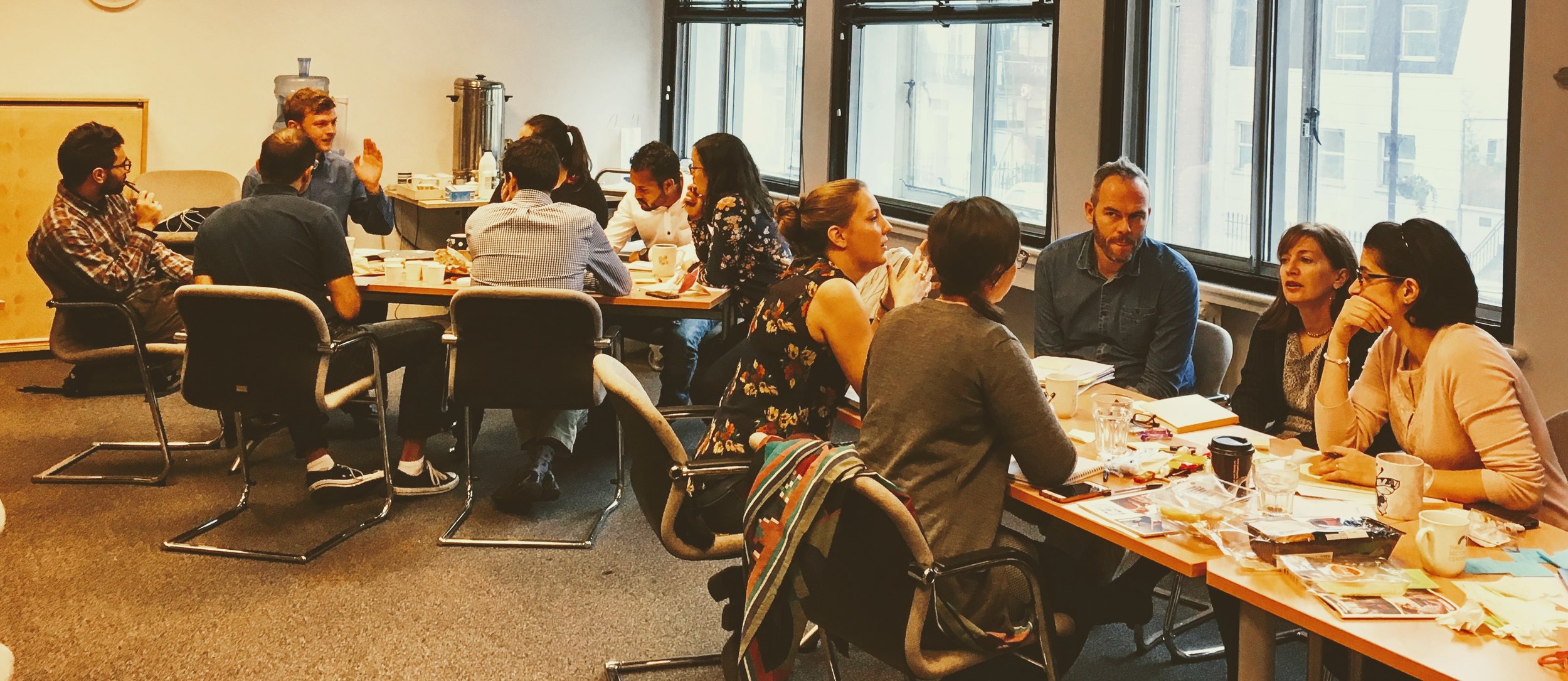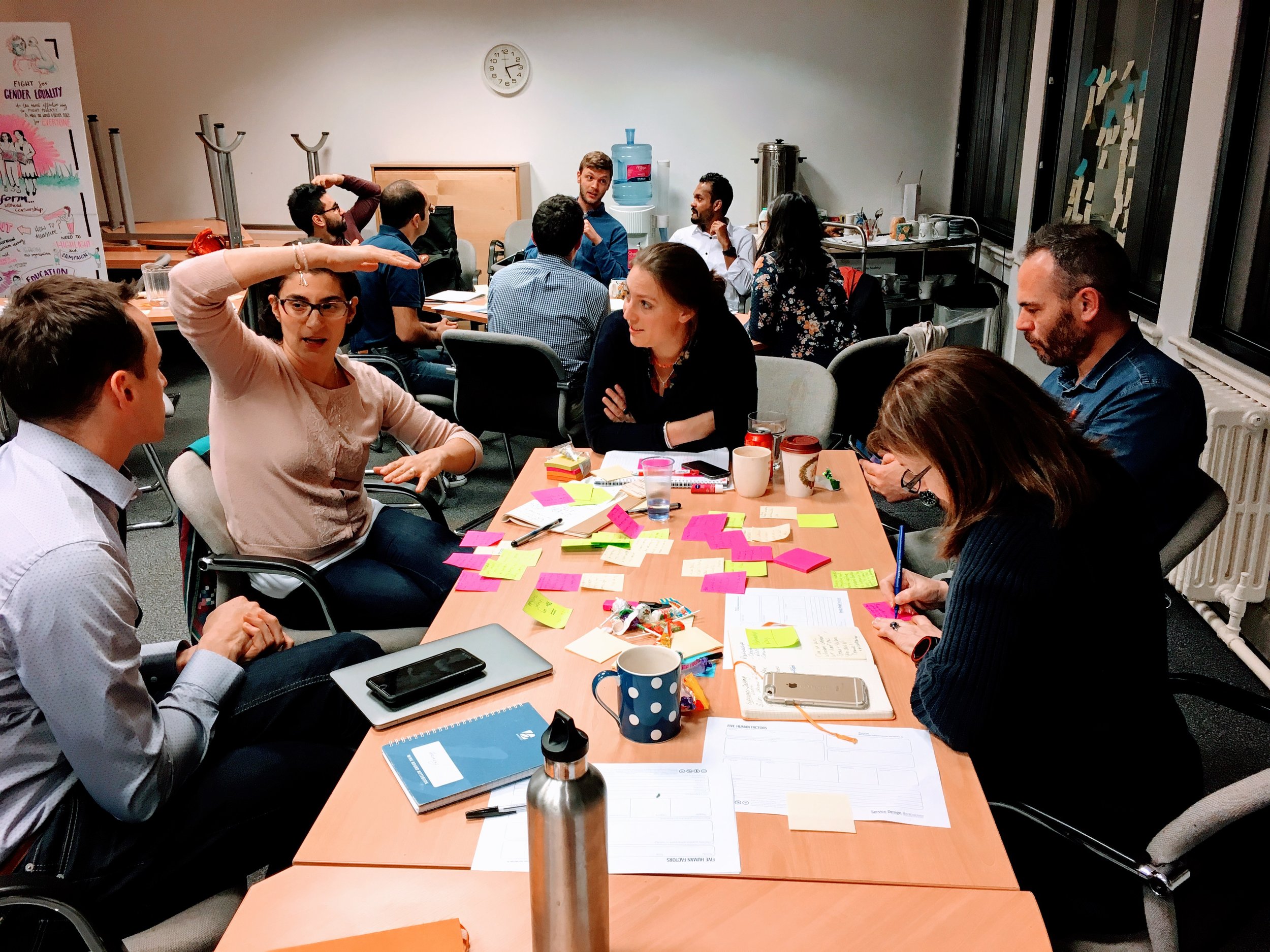workshop Facilitation case study @ philanthropy university
Working with nonprofit teams at Oakland, CA based Philanthropy University and London based Stars Foundation to introduce and apply a design thinking practice.
“I had the pleasure of hiring Nathan to lead a product research training for my organization in late 2016. We were very impressed with his ability to break down complex ideas and translate technical product approaches for a non-technical audience. He’s an amazing listener and great at bringing diverse teams together. ”
requested outcomes
There were two primary outcomes requested for this workshop:
Two organizations that had never met in person, one in California and the other in London, were being merged. They needed to come together to learn about each other and their customers
Neither organization was familiar with a human-centered design practice, so needed training and hands-on experience
We decided to bring the teams together in their London headquarters, and spend two days working hands on with each other to uncover assumptions, collaborate to uncover insights, and create real solutions to problems.
Participants
There were 22 participants, including engineers, community managers, partnership managers, and executives.
My Role
I was the course instructor, and worked with the executive team to build the course suited to the needs of their organizations.
Three teams work on concepts for products or services based on their current understanding of their target audiences.
Learning Outcomes
Using a backward design approach to course creation, I started with the final outcomes requested by the teams and crafted learning outcomes.
About this course
Intuition, often seen as a magical power that only certain people possess, is a fantastic source of product ideas. However, intuition is not magical - it is the result of synthesizing observations and empathizing with people to learn what they are trying to do, why they are doing it, and then finding ways to help them do it better.
This workshop will cover a framework for cultivating your intuition, methods for discovering and presenting new ideas, and techniques for testing those ideas with your audience. You will uncover your own assumptions and compare notes with your peers, and then use those assumptions to generate new product ideas. You will create the concept for a prototype of your idea, and then you will pitch the idea and get feedback from your colleagues. Finally, you will learn how to take the idea and get the vital feedback from people who will be impacted by your idea.
What you will learn
How to structure the innovation process using a human-centered practice
How to uncover and test assumptions
How to interview people
Techniques for analyzing & synthesizing research data
Tools for framing and presenting insights
How to generate concepts and turn them into testable prototypes
How to test prototypes and get feedback
The PRINCIPLES design thinking process coupled with the design innovation mindsets from 101 Design Methods by Vijay Kumar.
Predispositions: The participants spent time individually and collectively brainstorming and drawing insights from current institutional knowledge.
course outline
I developed a two and a half day course based on the time I had with the group and how much material and hands-on work was needed. Below is a sample of the activities and discussions from the first day.
40min: Introduction to design thinking, overview of innovation framework.
15min: Activity - What do we think we already know? We will uncover the assumptions the team has about their customers. (individual activity)
10min: Discussion and prep for future activity
15min: Introduction to research methods, selecting a research tool
15min: Interviewing - Interviewing is foundational to most research methods. Learn how to listen for empathy, how to structure notes, what to listen for and how to ask probing questions.
25min: Activity - Listening for empathy & discussion (pairs)
30min: Activity - Break into pairs and practice interviewing and note taking. (pairs) - Describe how you got to work this morning.
20min: Discussion. What did you discover?
20min: Organizing information to draw insights from research. Three specific techniques we'll cover: Affinity diagram, Ecosystem mapping, Personas. Start with affinity diagram, do activity, repeat, discuss at the end.
20min: Activity - Affinity diagram with assumptions (split the room in 2)
20min: Discussion
Focus on inclusion
Not everyone is comfortable operating in a group, especially when they are working with unfamiliar people. The activities consisted of individual, paired, and small group exercises to allow for a diverse audience to participate and get to know each other's thoughts and opinions before coming together in groups on topics they were interested in.
ice breakers & warm up games
I typically do icebreakers that will play a relevant role in the workshop later. I like to have the icebreakers build on each other, having people have to pay more attention to each other and the situation with each game. The total time accounts for moving around and explanations and teaching moments, as well as leaving time to keep going if it’s proving entertaining. As an example:
5 minutes: name game
Break into two circles, everyone will go around the circles and say their names. Do this 3-4 times. Then, play name tag - each person goes to where another person is, saying their name. It’s even okay if everyone is wearing name tags. This activity keeps people engaged, and gets everyone making eye contact and saying people’s names. And it’s easy, whew!
10 minutes: zip, zap, zop!
Switch circles up, and this time the participants are going to pass a word along. The words start with “zip zap and zop”, with each person passing the next word along. Everyone has to pay attention! Once everyone is comfortable, we have the word sender move to the position of the word receiver. And then just to shake things up, I’ll add in another three word rhyme that will be passed around at the same time. Chaos! Madness! Hilarity!
Teams taking time to get to know each other and discuss what they each know about their target audience
active instruction
Workshop participants participated in group discussions and got hands-on experience with the design process throughout the two day workshop. Activities included:
Paired interview / listening exercise
Individual post-it note brainstorm
Affinity diagram clustering
Group discussion and brainstorm
Experience-taking storytelling (telling another person's story as if it is your own, designed to help build empathy and listening skills)
Small group sharing of insights and concepts
Full class sharing of concepts and prototype ideas
Prototyping activity from workshop slides
A team deciding how to prototype their concept
Pitching activity from workshop slides
A team presenting concepts to the class
discovering design challenges
Workshop participants spent time working alone and in small groups, thinking about what challenges their target audiences face. The groups presented their insights and challenges to the rest of the workshop participants to get feedback and more broadly share this cross-functional knowledge.
Once challenges were identified, the top three were selected by the class with the help of the executive team and people self-selected into a group to work on concepts and prototypes to solve and test for the design challenges.
A team brainstorming solutions to problems discovered during the insights gathering phase.
Pitches
In the final activity of the workshop, the three teams spent the latter half of the second day working on concepts for services and products that might solve for the challenges their audience faces. The teams were asked to create 2-3 concepts and come up with ways to prototype the concepts.
In the final hours of the workshop before each team pitches their concepts, the teams work on ways to prototype their ideas.
Outcomes
Each of the three teams worked on solutions to the problems their customers face. In order to test their concepts, they decided on ways to prototype a simple version of their product or feature to quickly gather feedback, validate assumptions that lead to the solution, and iterate or dismiss the concept.
Each team created one or two strong concepts and articulated their approach for testing the concepts.
A team lead pitching one of their concepts and how they plan to prototype and test it.
“Presenting to a diverse group of participants, Nathan deftly distilled complex ideas into accessible, approachable pieces, nimbly supporting each participant without taking away from the process. Nathan exhibited deep listening skills, hearing and addressing unspoken questions along with those voiced. He exhibited grace under pressure, never losing his sense of humor and encouraging demeanor. Nathan is a rare leader who embodies both humility and command all at once. I look forward to the opportunity to engage with and learn from Nathan again soon.”
retrospective
I received positive feedback during and after the course for the content, the collaborative, hands-on activities, and for adjusting the course on the fly based on the needs of the teams. That said, I would make changes in future iterations of this workshop.
The primary outcome of the workshop was intended to be clearly articulated concepts that could be prototyped and tested with research. While the students had a need to learn how to arrive at testable prototypes, the real need to give the two diverse teams time and tools to collaborate and grow together became clear right away. I adjusted the course syllabus each day to give the teams the necessary room to spend time together brainstorming and discussing their ideas while still keeping them on a path to get testable concepts by the last day.
In the future I would build in more time for people to get to know each other, and make sure there is time for students to air their assumptions so they can come together ready to be creative and learn.
Another problem is that I tried to cover too much in too short a time. Even introducing a concept such as insights generation takes more time than I anticipated, especially when the students have a lot of pent up need to generate ideas based on their current understanding of their audience. I could have easily spent more time on any of the parts of the design process with multiple activities for each. As it was, I sometimes had to focus on a single activity when I had originally planned for two or three.
In the future, instead of trying to cover every part of the design process, I will focus on the parts that are most urgent for the team. I can conduct a pre-course assessment to better understand the current knowledge and abilities of the students, and link concepts to what they already know how to do and have the students teach each other. For example, the team in London is quite skilled at creating services. I could have asked someone from that team to prepare a brief discussion about how they approach service design, and then enhanced the discussion with an activity in which both teams work together to create a service concept that they could test.








